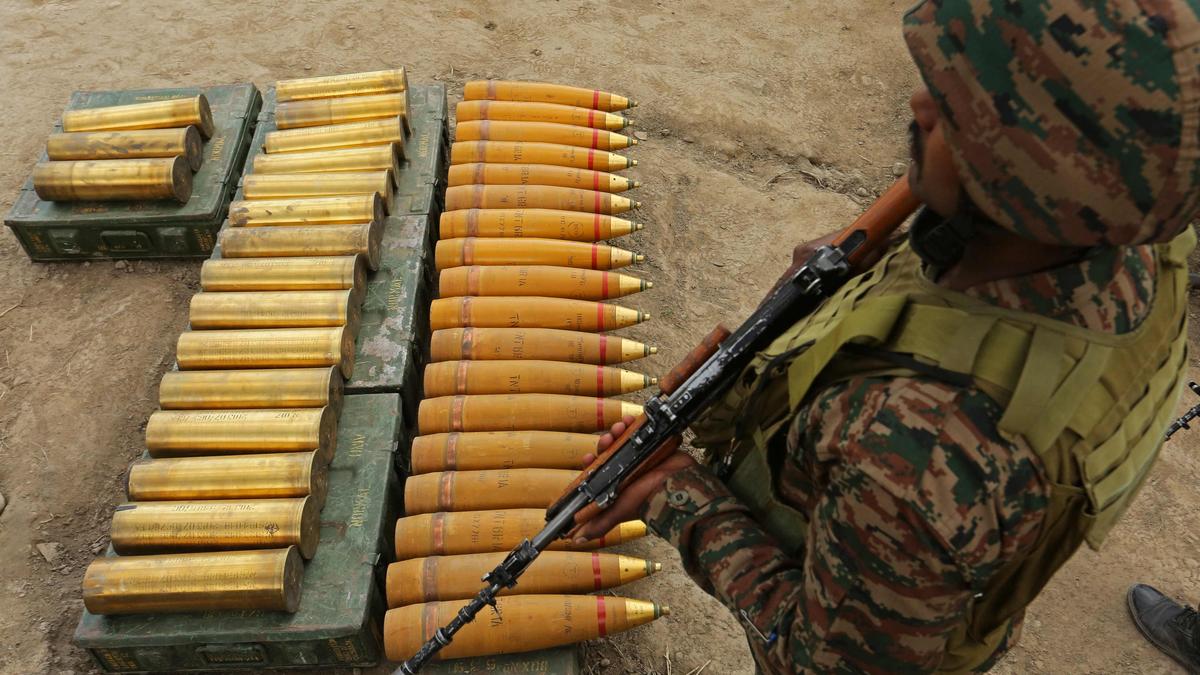An Indian army soldier stands next to artillery shells in Poonch sector of India’s Jammu region, on May 20, 2025. (Photo by Mukesh GUPTA / AFP)
| Photo Credit: MUKESH GUPTA
While India effectively utilised many of its indigenous defence systems during Operation Sindoor, it also relied on weapons built in collaboration with Israel, such as the SkyStriker drone, and those imported from Russia, such as the Pechora and OSA-AK missiles. Pakistan used Chinese-origin PL-15 missiles and Turkish-origin Unmanned Aerial Vehicles.

An analysis of arms transfer data from the Stockholm International Peace Research Institute shows that over the past decade, there has been a significant shift in the sourcing of weapons for both India and Pakistan. India has gradually reduced its dependence on Russia and has increasingly turned to Western countries such as France, the U.S., and the U.K. A significant portion of its arms imports also comes from Israel. The data reflect the quantity of weapons imported, without accounting for their firepower or operational role.
Chart 1A shows the country-wise share of India’s defence imports.
Staring from the 1960s, India began to consistently source more than 33% of its weapons from Russia (formerly the Soviet Union). This dependence peaked in the 1990s, when Russia accounted for an overwhelming 96.5% of India’s imports. From then, Russia’s share steadily dropped, falling to a still substantial 75% in the 2020s. This drop was offset by increased imports from other countries: in the 2020s, France accounted for over 9%, the U.K. for 5.5%, Israel for nearly 5%, and the U.S. for close to 3% of India’s weapons imports.
In contrast, Pakistan has historically sourced the majority of its weapons from both China and the U.S. over several decades. However, in the 2020s, China has emerged as Pakistan’s dominant arms supplier.
Chart 1B illustrates the country-wise share of Pakistan’s defence imports.
In the 2020s, nearly 95% of Pakistan’s arms imports came from China, marking a sharp rise from 41% in the 2010s and just 19% in the 2000s. Meanwhile, the U.S.’s share declined from nearly 67% in the 2000s to 38% in the 2010s to merely 0.85% in the 2020s.
Apart from overall arms procurement, specific weapons and aircraft were also points of discussion during the recent conflict. The Indian Air Force played a crucial role in “delivering precision strikes against terror infrastructure across Pakistan”. Additionally, the IAF’s control of the airspace proved “pivotal in protecting Indian airspace during retaliatory drone and UAV attacks”.
Chart 2A shows the country-wise share of India’s imports of weapons related to air power.
Chart 2B shows the country-wise share of Pakistan’s imports of weapons related to air power.
India’s dependence on countries apart from Russia is even more evident in this regard. In the 2020s, India has procured more than 55% of its weapons related to air power from France, the U.K., and Israel.
Pakistan’s dependence on China is also even more pronounced in this regard. Over the past three decades, between 50% and 85% of Pakistan’s air-related imports have come from China.
While the U.S.’s share in Pakistan’s arms imports has significantly declined and its share in India’s imports is only gradually rising, the superpower continues to dominate global arms exports overall. Chart 3 shows the country-wise share of global arms exports (in %).
In the 2020s, more than 65% of the world’s arms exports originated from the U.S. Russia’s share has dwindled to 5% in the 2020s, which coincides with its invasion of Ukraine.
Interestingly, China accounts for less than 2% of total exports worldwide in the 2020s. A significant portion of its limited exports (33%) is directed to Pakistan.
Chart 4 shows shows the country-wise share of China’s defence exports.
Source: SIPRI
Published – May 28, 2025 08:00 am IST
